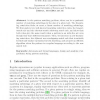Free Online Productivity Tools
i2Speak
i2Symbol
i2OCR
iTex2Img
iWeb2Print
iWeb2Shot
i2Type
iPdf2Split
iPdf2Merge
i2Bopomofo
i2Arabic
i2Style
i2Image
i2PDF
iLatex2Rtf
Sci2ools
FCT
2005
Springer
2005
Springer
A New Linearizing Restriction in the Pattern Matching Problem
In the pattern matching problem, there can be a quadratic number of matching substrings in the size of a given text. The linearizing restriction finds, at most, a linear number of matching substrings. We first explore two well-known linearizing restriction rules, the longestmatch rule and the shortest-match substring search rule, and show that both rules give the same result when a pattern is an infix-free set even though they have different semantics. Then, we introduce a new linearizing restriction, the leftmost non-overlapping match rule that is suitable for find-and-replace operations in text searching, and propose an efficient algorithm when the pattern is a regular language according to the new match rule.
| Added | 27 Jun 2010 |
| Updated | 27 Jun 2010 |
| Type | Conference |
| Year | 2005 |
| Where | FCT |
| Authors | Yo-Sub Han, Derick Wood |
Comments (0)

